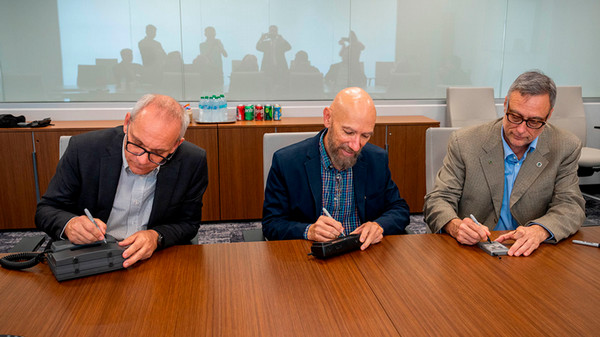Pioneers of mobile revolution share lessons, experiences with Auburn Engineering students
Published: Oct 1, 2024 2:00 PM
By Joe McAdory
Look beyond the curve and innovate for tomorrow. That’s the message three architects of the mobile revolution delivered to students and faculty on Monday, Sept. 30, at the Brown-Kopel Center.
Frank Canova, inventor of the first smart phone, Daniel A. Henderson, inventor of photo/video messaging and Neil Papworth, who created and sent the first-ever text message, answered questions and shared experiences in the 60-minute discussion, “Signal Strength: Pioneers of the Mobile Revolution,” presented by the Samuel Ginn College of Engineering.
“Every inventor thinks that they’re going to change to world,” said Henderson, whose 1993 picture and video messaging prototype, the Intellect, incorporated technology that is now ubiquitous in cell phones worldwide. “In reality, the market, technology and society will determine what will make those changes. In 100 years, none of us will be here. The point why you’re innovating is to work hard and make things better when you’re not here.”

Henderson, a former marketing representative for IBM and entrepreneur, said it’s important to understand problems technology can immediately resolve, but “look beyond that curve.”
“Sometimes your solution is looking for a problem to resolve,” said Henderson, who is featured on the Lemelson-MIT online wall of inventors, alongside Steve Jobs and Thomas Edison, among others. “Use that knowledge and bring it into what can be built today. Part of the problem and the discipline of inventions are the utilities that have the capacities to change even more.”
Take Canova and the first smart phone, for example. In 1992, Canova explored means to use a computer with touch screen technology — a cathode ray tube on top of a computer screen — when an idea suddenly sparked.
“I asked myself, ‘What if I put this on top of a keypad on the screen because I was already trying all sorts of other apps on the screen?’” said Canova, whose grandfather was an associate of Thomas Edison. “As soon as I put my cell phone on top of that computer screen, I realized you could marry two technologies together. Inventions start this way a lot of times when you have two very distinct things that are not necessarily intended for each other.”

He patented the IBM Simon in 1995. It’s not exactly an iPhone16, but architecture behind its development laid the foundation for today’s technology.
“There definitely remnants of just the original applications, which is beautiful about building technology,” Canova said. “Many say technology is a tool that other people build upon. There are so many applications today that I did not anticipate and leveraged the technologies that we created. Future technologies will continue to be built on today’s technologies.”
For Papworth, creating and sending the first text message in 1992 was all about “keeping people in touch.”
“Ideas produce solutions,” said Papworth, a 22-year-old test engineer at Sema Group Technologies in Berkshire, England, when he sent the first text message, “Merry Christmas,” to a Vodafone administrator who was, ironically, attending a Christmas party.
Papworth said his original device could send two messages per second.
“Today, systems can send hundreds of thousands of messages in a second,” he said. “I wasn’t thinking that night about all the applications that could be built from this. I was just doing my job. Looking back, I’m stunned about the many the uses of this thing. You can now message somebody across the world.”
In closing, Canova said, “We have the passion to change the world, but many of us won’t see that impact, or realize the impact we made, until we exhale.”
Media Contact: , jem0040@auburn.edu, 334.844.3447
From left, Daniel A. Henderson, creator of photo/video messaging capability, Frank Canova, inventor of the smart phone and Neil Papworth, who sent the first text message.

